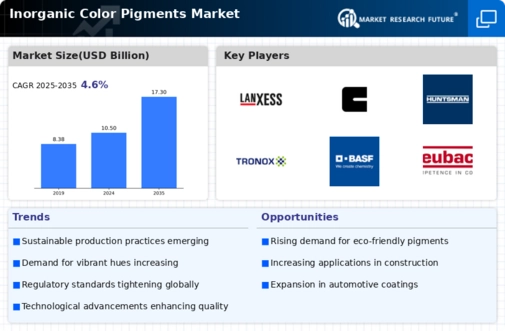Market Growth Projections
The Global Inorganic Color Pigments Market Industry is poised for substantial growth, with projections indicating a market value of 10.5 USD Billion in 2024 and an anticipated increase to 17.3 USD Billion by 2035. This growth trajectory reflects a compound annual growth rate of 4.63% from 2025 to 2035. The increasing demand for high-performance pigments across various sectors, coupled with advancements in production technologies, suggests a robust market outlook. As industries prioritize quality and sustainability, the Global Inorganic Color Pigments Market is likely to expand, driven by both established and emerging applications.
Growth in Automotive Industry
The automotive sector significantly influences the Global Inorganic Color Pigments Market Industry, as manufacturers increasingly prioritize high-quality coatings for vehicles. Inorganic pigments provide excellent durability and color retention, making them ideal for automotive applications. With the automotive industry projected to grow steadily, the demand for inorganic pigments is expected to rise correspondingly. This growth is underscored by the anticipated market expansion to 17.3 USD Billion by 2035, reflecting a compound annual growth rate of 4.63% from 2025 to 2035. As automotive manufacturers seek to enhance vehicle aesthetics and longevity, the reliance on inorganic pigments is likely to intensify.
Rising Demand in Construction Sector
The Global Inorganic Color Pigments Market Industry experiences a notable surge in demand driven by the construction sector. As urbanization accelerates, the need for durable and aesthetically pleasing materials increases. Inorganic pigments, known for their stability and UV resistance, are extensively used in paints, coatings, and construction materials. This trend is reflected in the projected market value of 10.5 USD Billion in 2024, indicating a robust growth trajectory. The construction industry's expansion, particularly in emerging economies, further fuels this demand, suggesting that the Global Inorganic Color Pigments Market will continue to thrive as infrastructure projects proliferate.
Diverse Applications Across Industries
The versatility of inorganic pigments across multiple industries significantly drives the Global Inorganic Color Pigments Market Industry. These pigments find applications in paints, coatings, plastics, and construction materials, among others. Their ability to provide vibrant colors and durability makes them a preferred choice for manufacturers. As industries continue to innovate and expand, the demand for high-quality inorganic pigments is expected to rise. This broad applicability suggests that the Global Inorganic Color Pigments Market will maintain a steady growth trajectory, supported by diverse end-use sectors that increasingly rely on the unique properties of inorganic pigments.
Technological Advancements in Pigment Production
Technological innovations in the production of inorganic pigments are reshaping the Global Inorganic Color Pigments Market Industry. Advances in manufacturing processes enhance pigment quality, reduce production costs, and improve color consistency. These developments enable manufacturers to meet the growing demand for high-performance pigments across various applications, including coatings, plastics, and construction materials. As a result, the market is likely to benefit from increased efficiency and reduced environmental impact. The ongoing research and development efforts in pigment technology suggest a promising future for the Global Inorganic Color Pigments Market, potentially leading to new product offerings and expanded market reach.
Environmental Regulations Favoring Inorganic Pigments
The Global Inorganic Color Pigments Market Industry benefits from stringent environmental regulations that favor the use of inorganic pigments over organic alternatives. Inorganic pigments are generally considered safer and more environmentally friendly, as they often contain fewer volatile organic compounds. This regulatory landscape encourages manufacturers to adopt inorganic pigments in various applications, including coatings and plastics. As sustainability becomes a priority for industries worldwide, the shift towards eco-friendly materials is expected to bolster the market. Consequently, the Global Inorganic Color Pigments Market may witness increased adoption rates, aligning with global sustainability goals and regulatory frameworks.





















Leave a Comment